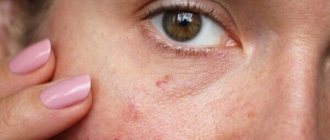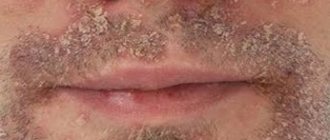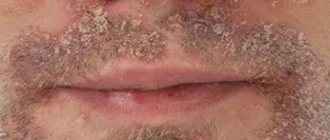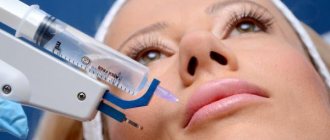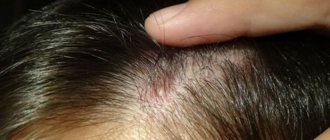A scar is a formation represented by connective tissue that forms at the site of skin damage (wound).
Scars are formed as a result of damage to the skin due to various etiological factors:
- mechanical injury,
- surgery,
- thermal burn,
- chemical burn.
The nature of the damaging agent, the degree of damage, anatomical location, duration of injury, as well as individual characteristics of wound healing determine the variety of types and forms of scars. The course of the scar process, in turn, dictates the need to use one or another treatment tactic that is optimal for each specific case, in order to achieve the best possible aesthetic result.
Types of scars
Among the types of scars, there are several main, most common:
Hypertrophic scarA hypertrophic scar is formed as a result of excessive filling of the wound defect with connective tissue; these scars are dense and protrude to varying degrees above the level of the adjacent skin, which makes them noticeable to others. The prerequisites for the formation of hypertrophic scars are the volume and depth of damaged tissue; course of the wound process with inflammatory and purulent-inflammatory manifestations; localization of the wound in the chest and shoulder girdle area, as well as the flexor and extension surfaces of the joint area; individual tendency to excessive scarring. | |
Normotrophic scarA normotrophic scar is formed when the course of the scar process is favorable, without the formation of a significant amount of excess connective tissue. However, this type of scar is characterized by an uneven surface of the skin over the scar and a pronounced border with unchanged skin. | |
Atrophic scarAn atrophic scar is formed as a result of insufficient volume of connective tissue compared to the volume of the wound defect. These scars “sink” below the level of the surrounding unchanged skin and have clearly defined boundaries. This type of scars is most often found in the forehead and dorsum of the nose. This type of scar includes stretch marks (striae). |
Keloid scarsKeloid scars are characterized by the fact that they significantly exceed the original wound defect in volume and area, and also continue to increase in size for a long time. This type of scar is difficult to treat, both therapeutically and surgically. |
What is a scar?
A scar is an area of disordered connective tissue that forms at the site of skin damage. For example, after an incision during surgery or injury.
Babykin A.V. surgeon, urologist-andrologist, candidate of medical sciences
Modern medicine does not allow us to COMPLETELY remove a postoperative scar or perform an operation so that the skin heals without scar formation. However, there are many methods that can make the scar almost invisible.
The purpose of this article is to dispel some of the myths about scar treatment that the medical Internet is full of. We will not dwell on specific methods (you can read about them, for example, on Wikipedia).
Scar treatment
If there is an immature form of the scar, physiotherapeutic treatment, local application treatment and injection drug treatment are carried out, aimed at reducing scar hypertrophy and speeding up their maturation.
An example of preparation for laser dermabrasion surgery of a patient with an immature hypertrophic scar:
If there is a mature form of the scar, it is possible to perform laser dermabrasion surgery. This operation is performed under local application anesthesia using a high-energy CO2 laser, which allows for ablation (evaporation) of excess amounts of scar tissue, which subsequently leads to smoothing of the skin texture.
Hyaluronic acid in the fight against atrophic scars
Another method that will be most effective if the scar “sinks” significantly, that is, disrupts the normal texture of the skin, is injections of hyaluronic acid. The mechanism of action here is the same as in the case of wrinkles and folds: the gel filler pushes out the cavity, filling the missing volume. As a result, the skin on the treated area is evened out.
In addition to the fact that the scar area will become perfectly smooth, you will also give your skin the opportunity to be additionally saturated with the nutrients it needs - it will become more hydrated, dense and healthy.
Hyaluronic acid is a natural compound in our body that is present in tissues. Thus, injections do not give the effect of a foreign filler, tissues perceive the substance injected into them as related, and the danger of rejection is eliminated.
This method is considered one of the safest and gives excellent aesthetic results. There are practically no contraindications to its use: if you are healthy and do not suffer from severe chronic diseases or bleeding disorders, you can use it (although in any case, you will need to consult our specialist first).
Zolotov Sergey Alexandrovich
- Candidate of Medical Sciences, surgeon, specialist in laser surgery.
- From 2003 to 2009 completed training at the State Budgetary Educational Institution of Higher Professional Education "Russian National Research Medical University" named after. N.I.Pirogov Ministry of Health of Russia.
- From 2009 to 2011, he completed his residency at the Moscow State Budgetary Healthcare Institution, Research Institute of Emergency Pediatric Surgery and Traumatology, specializing in Pediatric Surgery.
- In 2011, he completed training under the program of additional professional education of doctors in laser medicine at the State Scientific Center for Laser Medicine of the Federal Medical and Biological Agency of Russia. From 2011 to 2014, he studied full-time graduate school at the Moscow State Budgetary Healthcare Institution Research Institute of Emergency Pediatric Surgery and Traumatology.
He has extensive experience in removing various benign formations of the skin and subcutaneous tissue using laser surgical methods.
More than 5 years of experience in surgery.
When should you not deal with scars at home?
Before starting any treatment, including getting rid of scars, you should consult your doctor. It will help you determine the most effective way to fight in your case.
It is definitely not recommended to use traumatic or unreliable products at home.
Treatment at home should be completely abandoned if in the area of the scar
- redness, irritation, and swelling of the skin are noted
- eczema, herpes or other skin diseases were discovered
- vessels appeared, the color of the defect changed dramatically
"before" and "after" photos
Material and methods
At the first stage of our study, 43 women aged 15 to 27 years with established diagnoses of acne and acne complicated by atrophic scars were observed. All patients, depending on the clinical picture, were divided into two comparable groups: group A included 22 patients (acne complicated by atrophic scars) and group B - 21 (acne). All patients underwent buccal scraping with sterile cotton swabs to collect material for analysis, followed by a genetic study of the frequency distribution of gene polymorphisms ESR1, Col1A1, Col1A2, Col3A1, Col5A1, MMP1, MMP12, MMP2, MMP3, MMP7
.
The study results were assessed on a 3-point scale:
1 — homozygote frequent allele (norm/norm), which corresponds to the absence of an increased risk of developing the trait under study (average population risk);
2 - heterozygote (normal/mutation), which corresponds to a moderate risk of developing the trait under study;
3 - homozygous rare allele (mutation/mutation), which corresponds to a significant risk of developing the trait under study (the gene for this trait is a risk factor for the disease).
At stage II of the study, 50 patients were observed - 28 (56%) men and 22 (44%) women with severe acne, whose average age was 15.7 ± 1.4 years. As the main treatment, participants received a systemic retinoid (isotretinoin) in standard dosages (initial dose - 0.7-0.8 mg/kg/day, followed by a dose reduction to 0.4-0.5 mg/kg/day, course duration at least 6 months). After achieving IGA 0-1, patients with atrophic post-acne scars were divided into two groups: group 1 included 24 patients, group 2 - 26. Patients of group 1, after completing the course of treatment with isotretinoin, used the drug externally with a fixed combination of 0 .1% adapalene/2.5% benzoyl peroxide once a day for 6 months. Patients of group 2 did not receive any treatment. The clinical picture in patients of groups 1 and 2 was represented by atrophic scars, post-inflammatory pigmentation and foci of congestive erythema. The effectiveness was assessed taking into account the number of primary elements of acne and atrophic post-acne scars (5-point system of severity for each element of the rash on a visual analogue scale), as well as an overall assessment of the severity of scars (Scar Global Assessment - SGA).
Price list for medical services of the laser surgery department
Consultation
| Name | Cost in rub. |
| Initial consultation | 2 000 |
Research
| Name | Cost in rub. |
| Cytological examination | 500 |
| Histological examination | 2 800 |
Anesthesia
| Name | Cost in rub. |
| Application anesthesia | 500 |
| Infiltration anesthesia | 500 |
| Conduction anesthesia | 1 500 |
Bandages
| Name | Cost in rub. |
| Adhesive bandage | 300 |
| Aseptic dressing | 500 |
| Bandage with medicines | 1 000 |
Removal of formations using laser radiation
| Anatomical zone | Cost in rub. for 1mm in maximum diameter |
| Scalp | 500 |
| Hands, forearms, feet, legs | 500 |
| Neck, chest, abdomen, back, armpits, shoulders, hips, crotch | 600 |
| Forehead, temporal region, ears, postauricular region | 600 |
| Eyebrows, nose, nasolabial triangle, chin, cheeks, cheekbones, red border of lips | 700 |
| Lower upper eyelids | 850 |
| Ciliary edge of the eyelids | 1 000 |
| External genitalia - single elements* *per 1 mm. 600 rub. | 1 000 |
Removal of papillomas with a diameter of up to 2.0 mm
| Name | Cost in rub. for a unit |
| Neck, chest, abdomen, back, armpits, shoulders, hips, crotch | 300 |
| Lower upper eyelids | 500 |
| Ciliary edge of the eyelids | 1 000 |
Scar treatment
| Name | Cost in rub. |
| Drug injection into the scar | 1 200 |
| Laser dermabrasion (resurfacing) per cm² | 1 200 |
Removal of vascular formations using laser radiation*
| Name | Cost in rub. |
| Photodestruction of the vessels of the wings of the nose | from 5 000 |
| Photodestruction of cheek vessels | from 10 000 |
*exact cost depends on capillary density, repeated stage of vessel destruction minus 30%
Treatment of ingrown toenails using laser radiation
| Name | Cost in rub. |
| Marginal resection of the nail plate | 6 000 |
| Removal of hypergranulations | 1 900 |
| Nail plate removal | 3 500 |
| Complex plastic surgery for ingrown toenails | 8 500 |
Removal of lipoma, atheroma
| Name | Cost in rub. |
| Lipoma removal | 18 000 |
| Removal of atheroma up to 5 mm | 6 000 |
| Removal of atheroma from 5 to 10 mm | 12 000 |
| Removal of atheroma more than 10 mm | 18 000 |
Scars - symptoms and treatment
If the patient comes in at the time of injury, then for a scar of better quality, primary surgical treatment of the wound, excision of clearly non-viable tissue, and removal of foreign bodies to reduce contamination of the wound are important. The importance of a dressing appropriate to the type of wound cannot be overestimated [6]. Surgeons have been using both hydrogel and vacuum dressings for a long time and see their tremendous help.
Treatment of already formed scars should be based on the type of scar and its age. Treatment can be staged (and therefore long-term) and complex. In clinics where complex treatment of patients for aesthetic reasons is carried out, protocols for the rehabilitation and treatment of various types of scars are usually developed, so the patient after aesthetic surgery begins to work with a cosmetologist almost from the first day after the injury.
Surgical and conservative treatment is possible. Surgical involves excision of the scar, triangular or other type of plastic surgery. Sometimes it is enough to perform Limberg plastic surgery. The method is based on cutting out and mutual counter movement of two adjacent triangular flaps consisting of skin and subcutaneous fat. In this case, it is necessary to position the lines of the scar in greater accordance with the lines of skin tension in order to transform the scar from hypertrophic to long, but normotrophic, which does not cause concern.
Extensive scars can be successfully treated using the dermotension expander method, when an expander is placed under a nearby area of skin. The expander is a hollow silicone balloon, adapted for the gradual (over several weeks) introduction of saline into it. This leads to gradual dermotension (stretching) of the skin, which is subsequently used for skin grafting. In this way, in a few months you can get a large amount of skin identical in color and texture (for example, to cover the scalp).
Conservative methods may be controversial or supported by many years of research. Controversial methods include cryotherapy, radiation therapy, x-ray therapy for scars - they do not always give a good result. Sometimes their damaging effect is greater than can be predicted. Confirmed ones include injections of hormones, enzymes, plasma therapy, phonophoresis, etc. Research on cellular technologies, such as injections of stem cells or neofibroblasts, is of great value [13].
Also interesting are treatment methods using veropamil ointment, acemin, rubbing in vitamin E, and the use of cytokine preparations. It is advisable to develop these methods, as they can be effective and useful in identifying the processes occurring in the wound. But in practice, they can be difficult to apply due to the duration, labor-intensive or high cost of treatment.
Atrophic scars take a long time to treat, are difficult and may not give a clear aesthetic result. They use peelings, laser treatment, injections of collagen and hyaluronic acid, as well as darmabrasion - grinding off the surface of the epidermis. If dermabrasion is done very roughly, it can lead to the formation of new scars. Surgical methods include excision of an area of skin with stretch marks (after all, most often it is the abdomen with many stretch marks).
Normotrophic scars can be quite effectively treated with therapeutic methods to improve quality, for example, smearing with silicone gels and immoferase. These products will speed up the maturation of the scar and quickly turn it from red to white. In addition, a month after the injury, you can inject the scar with your own blood plasma or Spherogel, which will help make the scar as blurred as possible. If the scar is whiter than the surrounding skin, tattooing it is used with great success.
Hypertrophic scars respond well to treatment with injections of hormonal drugs, the use of hormonal ointments, and silicone gel applications, such as Kelo-Kot or Dermatix. The action of these drugs is based on the occlusive effect (moisture evaporation is blocked), scar hydration and reduction of collagen synthesis. Corticosteroid injections can help achieve rapid improvement in hypertrophic or keloid scars. Sometimes in practice, 1-2 injection procedures are needed to transform a hypertrophic scar into a normotrophic one. The keloid scar stops itching after the first procedure, which significantly alleviates the patient’s condition. The principle of action of corticosteroids is based on a powerful anti-inflammatory effect, inhibition of fibroblast division and increased activity of its own collagenase.
Injections of enzyme preparations such as hyaluronidase and longidase treat not only skin scars, but also deep cicatricial deformities such as Dupuytren's contracture. This is a scar degeneration of the palmar tendons, in which the fingers are bent towards the palm and their full extension is impossible.
Not only the injection will improve the condition of the hypertrophic scar, but also phonophoresis with these enzyme preparations, which increases the availability of treatment. Surgical treatment consists of triangular scar plastic surgery—reorientation of the scar line is performed so that its direction coincides with the skin tension lines.
ways to treat keloid scars , which means that there is no 100% effective method. Injection of hormones, such as Kenalog, significantly improves the quality of the scar and relieves itching. Pressotherapy in studies gives quite good results. This is constant pressure therapy, for example using an elastic pressure bandage. This can be done using compression garments or silicone plates. It was experimentally revealed that a pressure of 25 mm Hg. Art. for every centimeter of skin it compresses blood vessels, limits their growth and softens the scar, until it is completely smoothed out. Silicone plates dry the surface of the scar, extinguish pathological inflammation in the scar and also significantly alleviate the patient’s condition.
As with hypertrophic scars, good results can be expected from topical application of enzyme preparations (Fermenkol) or their injections into the scar tissue. It is not recommended to perform primary excision of a keloid scar. Otherwise, in response to inflammation, an even larger scar will grow at the site of the excised tissue. If a person has a state of homeostasis in which a keloid scar is formed in response to injury, it is logical to assume that by removing the existing keloid the doctor will cause a new injury greater than the previous one, which means with almost 100% probability the scar will also become keloid and involve some kind of amount of healthy skin. This type of scar requires careful attention; there should be no rush to treatment.
Just getting rid of acne scars on your face is not enough. Removing red spots
The first thing we offer after working with scars is a course of biorevitalization with 3% hyaluronic acid. This procedure very well lightens stagnant spots and evens out skin tone.
Finally, after six months or even a year, the time for the laser comes. The fact that we raised the bottom of the scar almost to the level of healthy skin will save it from aggressive resurfacing. Surface or medium grinding will be sufficient.
Please note that it is not the scar that is polished, but the skin surrounding it: as a result, it partially lowers to the level of the scar. The skin is evened out.
Video:
Laser scar modeling with a fractional erbium laser (laser dermabrasion). The procedure removes scars, “craters” of pores on the skin, and any consequences of post-acne. It is performed under anesthesia; the age of the scars does not matter.
Maria's review:
“When I was young, I suffered a lot from acne. They passed, but by the age of 25 my face had turned into one endless scar. Without exaggeration, white and red scars were piled one on top of the other.
Those who know will understand: even just to leave the house you need to carefully apply concealer, foundation and powder, but as a result you look no better than a young old woman.
There is no quick way to remove acne scars. Unlike acne, they do not go away on their own. Dealing with scars turned out to be more difficult than acne. I burned them out with chemical peels and with a laser - it helped, but I was not able to completely get rid of acne scars.
What I have after a year and a half of treatment with Vasilyev Maxim is very similar to a miracle - there are almost no signs of acne visible, the skin is smooth and beautiful.
How much patience a doctor must have who works for so long with such jeweler precision and brings the work to perfection. Thank you"!

